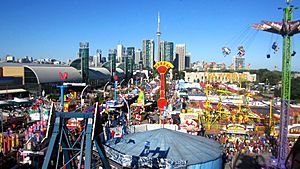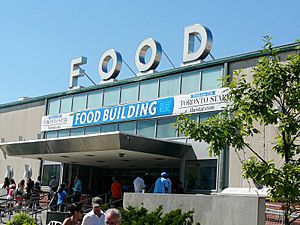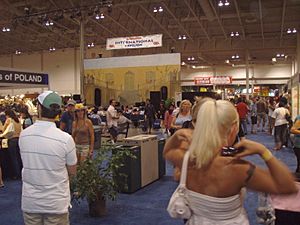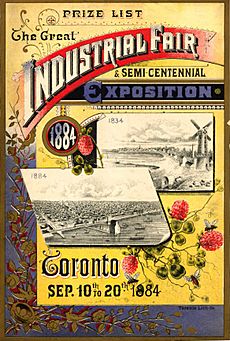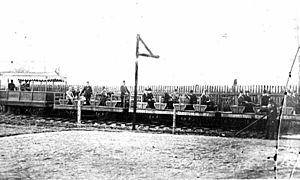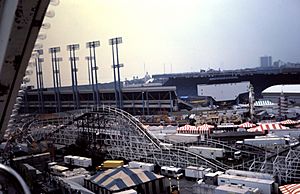Canadian National Exhibition facts for kids
Quick facts for kids Canadian National Exhibition |
|
|---|---|
 |
|
| Nickname | The Ex |
| Genre |
|
| Dates | 18 days (from third Friday of August to Labour Day) |
| Frequency | Annually |
| Venue | Exhibition Place |
| Location(s) | Toronto, Ontario |
| Country | Canada |
| Founded | 1879 |
| Most recent | August 16 – September 2, 2024 |
| Next event | August 2025 |
| Attendance | 1.604 million (2023) |
| Patron(s) | King Charles III |
The Canadian National Exhibition (CNE), often called The Ex, is a huge yearly fair. It happens at Exhibition Place in Toronto, Ontario, Canada. The fair starts on the third Friday of August and ends on Labour Day, which is the first Monday in September. With about 1.6 million visitors each year, the CNE is Canada's biggest yearly community event. It is also one of the top fairs in all of North America.
The CNE first started in 1879. Back then, it was called the Toronto Industrial Exhibition. Its main goal was to show off new ideas in farming and technology. Farmers, engineers, and scientists would display their latest discoveries. Over the years, the CNE has grown a lot. Now, it includes a fun carnival, live music, exciting parades, and an amazing air show. You can also find art displays, special shops, and all kinds of delicious foods. Some popular events are the Warriors' Day Parade, the Labour Day Parade, and the Canadian International Air Show.
Contents
Where the CNE Happens
The CNE takes place at Exhibition Place. This large area is about 192 acres (78 hectares) big. It is located along Toronto's waterfront, right by Lake Ontario. This spot is just west of downtown Toronto. Exhibition Place has many buildings and structures that are always there. Many of these buildings are very old and important. There are also outdoor stages for live music, like the CNE Bandshell. All the roads on the site are named after Canada's provinces and territories. The area also has a stadium for football and soccer, a basketball practice place, green spaces, fountains, and gardens.
Long ago, this site was home to Fort Rouillé. This was a French fort from the 1700s. You can still see a monument marking its spot. Later, when the British settled Toronto, the area became a military training ground. The CNE was allowed to use part of this land in the 1870s. By the 1920s, the fair used the entire area. In the 1950s, more land was added by filling in parts of Lake Ontario.
Fun Things to See and Do
The CNE lasts for 18 days and is packed with fun. You can enjoy live shows, see farm animals, and explore different exhibits. There is a huge carnival midway with many rides, games, and food. You can also find a casino, sports events, and shopping areas.
Shows and Attractions
The Canadian International Air Show is a big highlight of the fair. It has been happening since 1949. Amazing planes fly over Lake Ontario, just south of the CNE grounds. There are two main parades at the CNE. The Warriors' Day Parade happens on the first Saturday. It honors Canada's military veterans and features military vehicles. The Labour Day Parade of workers takes place on Labour Day.
The Canadian Armed Forces often have a display at the fair. Many buildings at the CNE hold different exhibits. You can find products from all over the world in the International Pavilion. The Arts, Crafts and Hobbies Building has unique items. The Enercare Centre hosts the International Pavilion, a garden show, and SuperDogs performances. It also has space for farm or industry displays and a live stage.
The Food Building is a very popular spot. It has many vendors selling food from different cultures. This shows off Toronto's diverse population. The Better Living Centre has the CNE Casino on one side. On the other side, it displays winners from farm produce competitions.
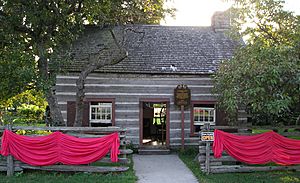
You can visit the "Scadding Cabin" log cabin. It was built in 1794 and is Toronto's oldest standing building. It was moved to the CNE grounds in the fair's first year. The cabin is only open to visitors during the CNE.
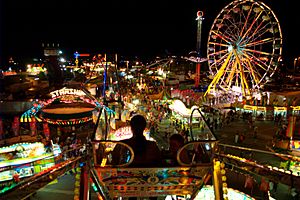
The fair has two midways with rides and carnival games. The Kiddie Midway is for younger children. It has smaller rides perfect for kids under 12. The main midway is for older kids and adults. It has many thrill rides, roller coasters, and swing rides. You can also find lots of carnival games and food vendors there. The CNE also has a "sky ride." It's like a ski-lift that carries people across the grounds.
The Coca-Cola Coliseum hosts live shows. These have included high-wire acts and ice skating shows. The Bandshell is used for daily music and nightly concerts by famous performers. You can also find other outdoor entertainment around the grounds. This includes beer gardens, musical acts, acrobats, and children's shows.
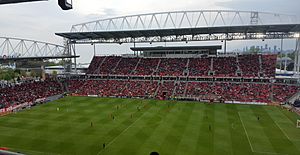
BMO Field is a large stadium in the middle of the CNE grounds. It is home to two professional sports teams from Toronto. These are the Toronto Argonauts Canadian football team and the Toronto FC soccer team. Both teams play at least one home game during the fair.
The CNE also holds several sports tournaments. At Coronation Park, there are youth baseball and girls' fastball tournaments. At the OVO Athletic Centre, the CNE holds a 3-on-3 basketball tournament.
Every night, live music is played at the CNE Bandshell. This outdoor stage has hosted many famous entertainers over the years. During the fair, other stages are set up with live music in different areas.
Delicious Food
You can find many food options all over the CNE. The CNE Food Building has a huge variety of choices. This includes desserts, international foods, and fast food. You can also try unique and fun items. There are also healthy, vegetarian, and halal food options. The Food Building opened in 1954, so it celebrated its 70th anniversary in 2024!
Since 2012, the CNE has also had a "Food Truck Frenzy." This event brings many food trucks to Princes' Boulevard. They serve all kinds of special foods. A "Craft Beer Fest" was added in 2015 and is still part of the event.
Shopping Fun
There are many places to shop at the CNE:
- Queen Elizabeth Building: Here you can find Arts, Crafts and Hobbies.
- Enercare Centre: This building has the Gaming Garage, Home and Garden Pavilion, International Pavilion, Shoppers' Market, and Warehouse Outlets.
- Outdoors: Many booths line the streets of the fairgrounds.
History of the CNE
The idea for the CNE started way back in 1846. That year, the Provincial Agricultural Fair of Canada West was held in Toronto. It showed off farm products, manufactured goods, and art. The fair was a success, but it moved to different cities each year.
In 1878, the fair returned to Toronto. After this, Toronto City Council wanted the fair to stay in Toronto permanently. Even though the Provincial Agriculture Association had other plans, Toronto decided to create its own permanent fair. This new fair, called the Toronto Industrial Exhibition, opened on September 2, 1879. It lasted for three weeks and had over 100,000 visitors.
As the fair grew, it became a place to see the newest technology. Visitors saw electric trains in 1883, Edison's phonograph in 1888, and "wireless telegraphy" in 1899. Radio was shown in the 1920s, and television in 1939.
In 1903, the fair was officially renamed the Canadian National Exhibition.
During the First and Second World Wars, the CNE grounds were used by the Canadian military. Buildings became barracks and training centers. The CNE was closed to the public during these times. It reopened in 1947 after the Second World War ended. In 1949, the Canadian International Air Show started at the fair. In 1968, the CNE was allowed to open on Sundays for the first time.
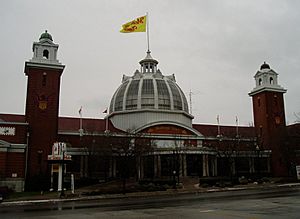
In the 1990s, some older rides and buildings were removed. New attractions were added, like the Medieval Times dinner theater in 1993. This show still operates in the Government Building today.
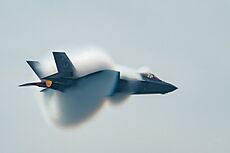
In 2003, the CNE celebrated its 125th anniversary. In 2010, the CNE became known as the "greenest" fair in North America. In the 2010s, the CNE added more entertainment. Olympic ice skaters like Tessa Virtue, Scott Moir, and Elvis Stojko performed in ice skating and acrobatics shows.
The CNE also featured a zip line ride in 2013 and 2014. It was very tall and long! In 2016, water ski shows returned to the waterfront. The CNE also started the Innovation Garage, showing new inventions.
In 2020 and 2021, the CNE was cancelled because of the COVID-19 pandemic. This was the first time it had been cancelled since World War II. The CNE lost a lot of money during these years.
The CNE happily reopened in 2022. It received funding from the Canadian and Ontario governments to help it return. New attractions included a nightly drone show and a multimedia show. The 2023 CNE had over 1.6 million visitors! It featured a Fountain Show, the Canadian International Air Show, and an Ice Skating and Acrobatics Show with Elvis Stojko. The CNE also celebrated the 130th anniversary of the Ferris Wheel by bringing in the Super Wheel. This huge Ferris wheel had climate-controlled cabins with amazing views.
How the CNE Helps the Economy
The CNE brings a lot of money to the Toronto area and the province of Ontario each year. For example, in 2022, the CNE brought in about $112 million for the Greater Toronto Area. It also created many jobs. About 1,200 people are hired each spring to plan the fair. During the fair itself, another 3,500 people work for food vendors, exhibitors, and other partners. For many young people in Toronto, working at the CNE is their very first job!
The CNE works with many companies and has space for over 700 exhibitors. Both Canadian and international businesses are part of the CNE. The CNE also helps promote tourism to Toronto and Ontario.
How the CNE is Organized
The Canadian National Exhibition is run by the Canadian National Exhibition Association (CNEA). This group has a volunteer Board of Directors. The CNEA follows rules set by the Province of Ontario. Exhibition Place, where the CNE happens, is owned by the City of Toronto.
For many years, the CNEA worked closely with the City of Toronto. In 2013, the CNEA became an independent organization. This means it can now make its own decisions and reinvest its profits back into the fair. This helps the CNE grow and offer even better experiences each year.
The CNEA has over 125 members, including people and groups from different areas like farming, manufacturing, and arts. These members help elect a Board of Directors each year.
In March 2022, Darrell Brown was named the Chief Executive Officer (CEO) of the CNEA. He helped the organization get important funding to keep going after the pandemic.
See also
- List of festivals in Canada
- List of festivals in Ontario
- List of festivals in Toronto


